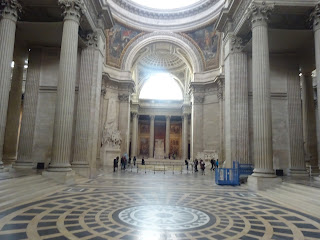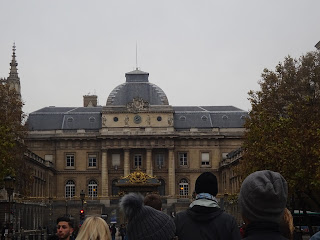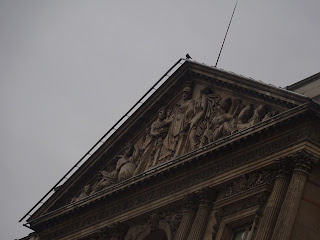 |
| Yo girl has arrived! |
 |
| Flying over Paris |
11th November 2016, was cloudy day in Paris, the sun hid behind the clouds leading to mild showers and slight darkness which made the city even more romantic. It was a normal winter morning in Paris, but this particular day was my first day in Paris. Before this visit, the term Paris had always been associated with romance, passion, perfumes, cheese, baguettes, crepes, french fries and everything in between. I was curious to experiment and learn about all these things, but the real reason I was in Paris was one woman who lived here a little more than a century ago.
 |
| When in France, eat lots of French fries |
She was born in Warsaw Poland, the youngest of five children of Prof. Sklodowski, . She lived at a time when women had little to no role outside their homes, which seemed to justify why no university in Poland admitted women. Even though her father wanted higher education for his daughters, he couldn’t afford it on a teacher’s salary and especially not if the only option for women was to study in Paris or St. Petersburg. After graduating high school with a gold medal, this little girl, now 17, traveled to Szczuki, a small Polish village, to work as a governess to put her sister, Bronya through college in Paris. As a governess she worked hard to save money and even volunteered her extra time to teach peasant children. The deal was that once Bronya completed her degree, she would return the favor, a deal that was honored. She got accepted to the University of Paris where lack of finances forced her to work even harder sometimes to the point of starvation. After completing her studies, she worked as a researcher, where her search for a proper lab equipment led her to her future husband, a French scientist. She was intensely curious about recently discovered radiations by Henri Becquerel’s, a curiosity that led her to explain radioactivity-a very novel concept at the time. Even though she deserved some credit, only her husband was nominated for a Nobel Prize. Her husband, a nobleman declined the nomination unless his wife received one too. Against all odds, the power couple together with Henri Becquerel did win the 1903 Nobel prize in Physics. We know bad things happen to good people, because 3 years later her husband and partner died tragically by slipping in the wheels of a horse drawn chariot. To add the cherry on top, she received nothing in the way of sympathy, as a matter of fact, she got accusations of having an affair with Paul Langevin, a student of her husband. Being the hero she was, she endured it all, the bricks people threw at her apartment, the windows they shuttered, the media attacks and everything in between. She directed this energy to more research, this time separating Radium as a metallic element and without question this work won her another Nobel Prize in November 1911. Unlike what most people would do with the $800,000 prize money, she gave it all to the French Government, to help with the First World War. As a matter of fact, she was a true minimalist because whenever she had more than enough money, she donated it to aids for the poor and immigrants, she even gave up her gold medals to be melted, something which the government respectfully declined. During the war, she invented radiology cars and fought against all odds to have them deployed at the war front. These cars performed X-ray examination on injured soldiers, precisely locating metals. They not only saved lots of lives, but also trained many women including her daughter, Irene in the skill of nursery and religion. As her work grew, so did her fame. With a humble heart she accepted Radium donations and accolades from Universities all over America. The world suffered a dent on 4th July 1934 when she died of aplastic anemia due to prolonged exposure to radiation, a true martyr to her craft.
 |
| The one and only Marie Curie |
You may know her by the name Marie Curie, wife to Pierre Curie, mother to another Nobel Prize winner Irene Curie. Marie lived a good life, through her struggles with money, patriarchy and acceptance she became a hero. She is the first woman to win not one but two Nobel Prizes. She taught the underprivileged, cured soldiers, discovered elements and at a time when women were not allowed to, she took the path less taken. In 1995, she joined her kind, the greatest minds of France, when her and Pierre's remains were stored in the Paris Pantheon. Once again, she became the first woman to be laid there. I came across Marie's biography in high school and she is a major reason as to why I pursued Engineering.
Knowing Marie’s story, I wanted it to come to life, I wanted
to walk the streets she walked, wander about the Latin Quarter, eat the food she ate, read the books she read and maybe perhaps be her for a day. My
priority for the day was to visit the Curie Museum which used to be her laboratory at the Radium Institute; it now contains an exhibition of the Curie's work. I started my journey quite early to
the museum, as I was approaching from Rue Pierre et Marie Curie, I was expecting to see open gates. I didn’t realize it was a Saturday and when you are touring, you lose
track of time and days. On Saturdays, the museum only opens at 13:00 so I either
had to wait or forget it all together since my time in Paris was so short that
no other time was convenient. You can imagine the disappointment and the hustle
of rerouting my day again. As I was aimlessly walking figuring out what to do next, I
stumbled across a building you are not
allowed to ignore – The Pantheon.
 |
| Stumbling upon the Pantheon |
 |
| The Pantheon and all her glory |
Pantheon is French for ‘a group of famous or important people’. It is a place where legends rest in peace after an exemplary life they led on earth. Designed with the magnificence of Greek architecture, the Pantheon has 4 minor domes surrounding the big dome on all four corners. It was was designed by architect Jacques-Germain Soufflot to be a church but ended up serving a purpose matching its grandeur.
In the pantheon lie remains of the likes of Marie Curie, Pierre Curie, Victor Hugo; the writer of the ‘The Hunchback of Notre Dame’, Louis Braille; the inventor of Braille, the famous natural philosopher Voltaire du Chatelet among many others. Even though all I see were vaults, paintings and statues, this place made me question my entire existence.
 |
| Appreciating the work of Soufflot |
 |
| Braille also lies in the Pantheon |
 |
| The Pantheon dome |
 |
| Works of art at the pantheom |
In the pantheon lie remains of the likes of Marie Curie, Pierre Curie, Victor Hugo; the writer of the ‘The Hunchback of Notre Dame’, Louis Braille; the inventor of Braille, the famous natural philosopher Voltaire du Chatelet among many others. Even though all I see were vaults, paintings and statues, this place made me question my entire existence.
 |
| Stumbling upon Marie Curie |
 |
| ... and Pierre Curie |
 |
| A lovely letter from a fellow Marie fan |
Later that day I went on a free walking tour where we
visited all the must-see spots like the Notre Dame Cathedral, the Louvre, the Effiel Tower and a lot more.
I learnt a great deal about the Kings and Queens of France including Marie Antoinette, King Louis XVI King Henry and King Philip, the French Revolution and its connection to wide streets. I also understood what makes the French, well French. One might conclude that they are plain-right lazy and prop-estrous, they just don’t work on uninteresting things, a culture propagated by their kings and queens.French men and women work on whatever they are passionate about and you will see it in their architecture, paintings, music and science. Sometimes, that is that all that’s required of a hero.
Even in all the pleasantries, at some point I found Paris to be a little overrated, in addition to being ultra-expensive compared to Lisbon (where I flew from), it was very chaotic and overcrowded. Like most cities in the world, I'll remember Paris through my encounters with the people, from the random strangers who helped with my suitcase at the metro, to the long-gone heroes like Marie. Most importantly Paris remind me how far passion can go. Unlike Marie Curie I probably won’t be buried in the Pantheon or win a Nobel Prize but I’ll be happy dying having left my mark. I slept that night pondering on Marie’s words:
 |
| If you look closely, you'll see Pont Neuf |
 |
| Lover's locks at the bridge |
 |
| Arc de Triomphe |
 |
| Streets of Paris (and gloomy weather?) |
 |
| Can you see the Eiffel Tower? |
 |
| #Paris |
 |
| Fountain Place, St. Michel |
 |
| The Notre Dame Cathedral |
 |
| More lover's locks |
 |
| Arc de Triomphe |
 |
| Ferris Wheel |
 |
| Who am I to ignore gold statues. |
 |
| Aaan more gold |
I learnt a great deal about the Kings and Queens of France including Marie Antoinette, King Louis XVI King Henry and King Philip, the French Revolution and its connection to wide streets. I also understood what makes the French, well French. One might conclude that they are plain-right lazy and prop-estrous, they just don’t work on uninteresting things, a culture propagated by their kings and queens.French men and women work on whatever they are passionate about and you will see it in their architecture, paintings, music and science. Sometimes, that is that all that’s required of a hero.
Even in all the pleasantries, at some point I found Paris to be a little overrated, in addition to being ultra-expensive compared to Lisbon (where I flew from), it was very chaotic and overcrowded. Like most cities in the world, I'll remember Paris through my encounters with the people, from the random strangers who helped with my suitcase at the metro, to the long-gone heroes like Marie. Most importantly Paris remind me how far passion can go. Unlike Marie Curie I probably won’t be buried in the Pantheon or win a Nobel Prize but I’ll be happy dying having left my mark. I slept that night pondering on Marie’s words:
“Nothing in life is to be feared—it is only to be understood.”
For a good overview of Marie Curie, I recommend this book.
Till next time.
For a good overview of Marie Curie, I recommend this book.
Till next time.


















No comments:
Post a Comment
Drop in what you have to say ... in the spirit of an amazing life..:)